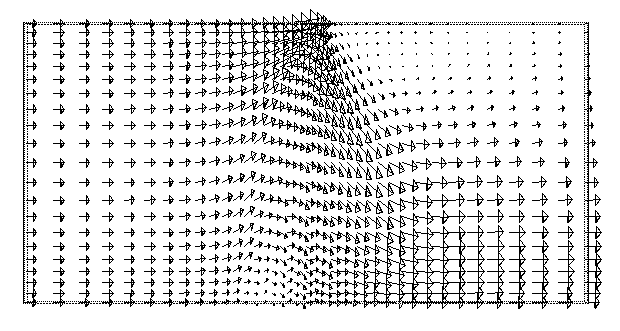LAGRANGIAN - EULERIAN MODELLING OF SPRINKLER SYSTEMS
Sprinkler systems are now widely used in buildings to protect against fire due to their proven effectiveness. However, as greater reliance is placed upon such systems for fire safety it becomes more important that we understand and are able to predict their behaviour. To this end the Fire Safety Engineering Group is developing techniques for the modelling of sprinkler sprays in fire environments.
The approach adopted is that of computer modelling using CFD techniques. Since it is necessary to consider both smoke and water droplet flows the problem becomes one of two phases, a continuous (air/smoke) phase and a discrete (water droplet) phase. The continuous phase is modelled using the now established field modelling technique. The discrete phase is modelled by determining the trajectories of a representative sample of particles. The two phases are coupled using the Particle-Source-In Cell (PSI Cell) method. This is an alternative approach to the Eulerian - Eulerian method developed by the FSEG.
In this method the particle trajectories are recalculated at the end of each iteration using the continuum solution just obtained. These trajectories are then used to determine the sources of mass, momentum and enthalpy to each cell of the continuum phase from the particles passing through them. These sources are in turn used in the next iteration of the continuum phase solution procedure to obtain a new continuum solution. The particle trajectories can now be recalculated using a flow field which has been affected by their presence. This procedure is repeated iteratively until convergence to a solution is obtained. The result is flow, temperature etc. fields for the air/smoke continuum phase and a set of trajectories plus size and temperature histories for the water droplets. The whole method is known as the Lagrangian approach. It is implemented at the University of Greenwich using a particle tracking suite written in house coupled to various CFD codes such as CFDS-FLOW3D.
To demonstrate and validate the model a simple 2D steady state system was modelled, viz a co-current spray dryer. This was specified as a duct 1.5m wide by 16.8m tall with gravity acting down it. A rectangular, cartesian, but non uniform grid comprising 50 x 175 cells was fitted to this domain.
Air flowed in at the top at 2.0m/s and out at the bottom. It was modelled as compressible, turbulent, non-isothermal and with no-slip atthe walls. Initial temperature was 20oC and initial relative humidity 30%.
The water spray was injected into the duct from both sides 3.05m from the top. It was represented by a total of 30 trajectories comprising 5 initial angles and 3 droplet sizes. Initial angles varied uniformly from 25o to 35o and droplet sizes were 740, 1000 and 1380m diameter.
All results obtained agreed quantitatively with expectation and with results for similar calculations published in the literature. The model is now being used to simulate the behaviour of sprinkler systems. The figures depict the behaviour of a ceiling mounted sprinkler subjected to a cross flow of 1ms-1 entering the corridor from the left. The initial symmetrically distributed water spray trajectories are deflected downwind (figure 1) and a large recirculation develops within the gas field just behind the sprinkler head (figure 2).

Figure 1

Figure 2
Reference:
Fire - Sprinkler Spray Interaction Modelling using an Euler-Lagrange Approach. Authors: R N Mawhinney, E R Galea, M K Patel. Proceedings of the 7th Intern Fire Science and Engineering Conference: Interflam'96, pp 841-845, St John's College, Cambridge, England, March 1996, compiled by C Franks and S Grayson, Publ by Interscience Communications Ltd, London, UK, 1996. ISBN 0 9516320 9 4.
See publications # 88, 84, 81, 80

